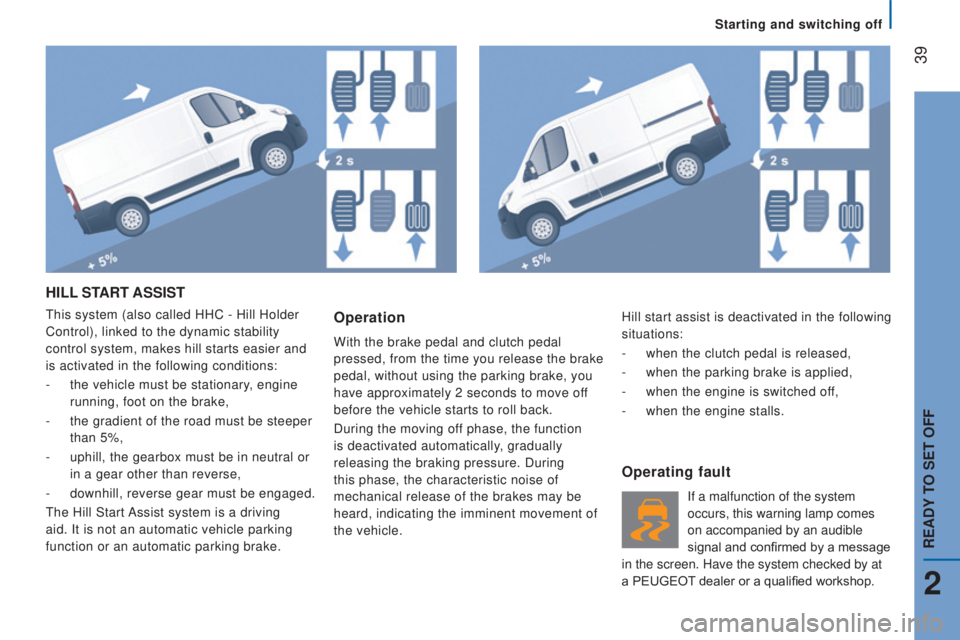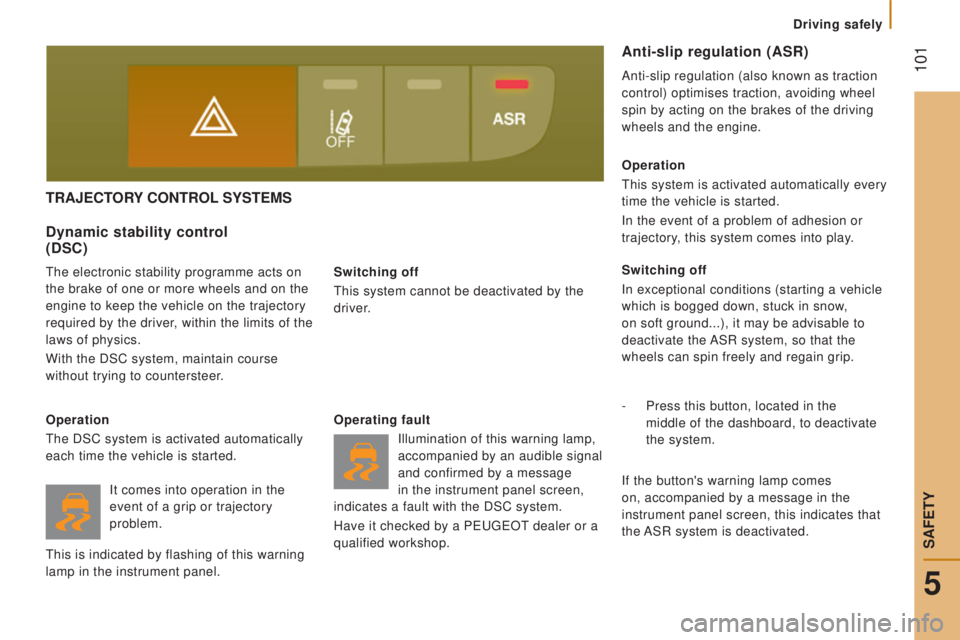2015 PEUGEOT BOXER brakes
[x] Cancel search: brakesPage 8 of 276

6
ExtErIor
Reversing camera 95
3rd brake lamp 149, 154
Left-hand side:
Fuel filler cap, fuel tank
134
Fuel cut-off 135
AdBlue filler cap, tank 136-139topping-up the AdBlue additive 140-141
Load space
81-83
Rear doors 21
Rear lamps, direction indicators, foglamps
45, 149, 153-154
Number plate lamp 154
Rear parking sensors
94
Spare wheel, changing a wheel, jack, tools
156-160
Inflating, pressures 162, 182
Snow chains 125
towing, lifting 163towbar 121-122
Removable towball 164-167 Dimensions
172-176
Accessories
124
Roof rack, roof bars 123
Brakes, pads
129, 132tyres, pressures 162, 182
Braking assistance systems 99-100trajectory control 101-104
Pneumatic suspension 96-97 Key, remote control, battery
14-17
Starting 18, 38-39
Central locking 22
Confidential card 18
Alarm 19
Wiper blade
155
Door mirror 85
Side repeater 152
Opening/closing doors
20-22
Remote control 14-15
Autoclose 87, 90temporary puncture repair kit 161-162
Front lamps, direction indicators,
front foglamps
45, 149-152
Headlamp beam height adjustment
47
Headlamp wash 48
Changing bulbs 149-152
ExtErIor
Location
Page 41 of 276

39
HILL StArt ASSISt
this system (also called HHC - Hill Holder
Control), linked to the dynamic stability
control system, makes hill starts easier and
is activated in the following conditions:
-
the vehicle must be stationary, engine
running, foot on the brake,
-
the gradient of the road must be steeper
than 5%,
-
uphill, the gearbox must be in neutral or
in a gear other than reverse,
-
downhill, reverse gear must be engaged.
the Hill Start
Assist system is a driving
aid. It is not an automatic vehicle parking
function or an automatic parking brake.operation
With the brake pedal and clutch pedal
pressed, from the time you release the brake
pedal, without using the parking brake, you
have approximately 2 seconds to move off
before the vehicle starts to roll back.
During the moving off phase, the function
is deactivated automatically, gradually
releasing the braking pressure. During
this phase, the characteristic noise of
mechanical release of the brakes may be
heard, indicating the imminent movement of
the vehicle.
operating fault
If a malfunction of the system
occurs, this warning lamp comes
on accompanied by an audible
signal and confirmed by a message
in the screen. Have the system checked by at
a PEUGEOT dealer or a qualified workshop. Hill start assist is deactivated in the following
situations:
-
when the clutch pedal is released,
-
when the parking brake is applied,
-
when the engine is switched off,
-
when the engine stalls.
2
rEAdY to SEt oFF
Starting and switching off
Page 103 of 276

101
trAjEctorY controL SYStEMS
Switching off
this system cannot be deactivated by the
driver.
dynamic stability control
(dSc)
the electronic stability programme acts on
the brake of one or more wheels and on the
engine to keep the vehicle on the trajectory
required by the driver, within the limits of the
laws of physics.
With the DSC system, maintain course
without trying to countersteer.
operation
the DSC system is activated automatically
each time the vehicle is started.
operating fault
Illumination of this warning lamp,
accompanied by an audible signal
and confirmed by a message
in the instrument panel screen,
indicates a fault with the DSC system.
Have it checked by a P
eugeOt dealer or a
qualified workshop.
operation
this system is activated automatically every
time the vehicle is started.
In the event of a problem of adhesion or
trajectory, this system comes into play.
Switching off
In exceptional conditions (starting a vehicle
which is bogged down, stuck in snow,
on soft ground...), it may be advisable to
deactivate the ASR system, so that the
wheels can spin freely and regain grip.
-
Press this button, located in the
middle of the dashboard, to deactivate
the
system.
Anti-slip regulation (ASr)
Anti-slip regulation (also known as traction
control) optimises traction, avoiding wheel
spin by acting on the brakes of the driving
wheels and the engine.
If the button's warning lamp comes
on, accompanied by a message in the
instrument panel screen, this indicates that
the ASR system is deactivated.
It comes into operation in the
event of a grip or trajectory
problem.
this is indicated by flashing of this warning
lamp in the instrument panel.
5
Driving safely
SAFetY
Page 106 of 276

104
Hill descent control
System that provides assistance when
descending on surfaces with poor grip (mud,
gravel...) or on a steep gradient.
this system reduces the risk of slip or loss
of control of the vehicle while descending
a hill.
It keeps the vehicle at a steady speed during
a descent by acting independently and with
varying force on each of the brakes. Switching off
Press this button, located in the middle of the
dashboard, to deactivate the system; the indicator
lamp in the button goes off.
Above 30 mph (50 km/h), the system is completely
deactivated; the indicator lamp in the button goes off.
operating fault
If a fault occurs with the hill
descent control system, this
warning lamp comes on.
Have the system checked by a P
eugeOt
dealer or a qualified workshop.
Switching on
On starting the vehicle, the system is
deactivated.
With the speed below 18 mph (30 km/h)
press this button, located in the middle of
the dashboard, to activate the system; the
indicator lamp in the button comes on.
Once the vehicle starts its descent, you can
release the accelerator and brake pedals;
the indicator lamp in the button flashes.
the brake lamps come on automatically
when the system is brought into operation.
If the speed of the vehicle exceeds 18 mph
(30 km/h), the system is automatically
deactivated, but the indicator lamp in the
button stays on.
the system reactivates automatically as
soon as the speed of the vehicle drops
below 18 mph (30 km/h).
For the system to operate, the slope
must be steeper than 8%.
Do not use the system with the gearbox in
neutral.
engage an appropriate gear for the speed of
the vehicle, to avoid the engine stalling.
You can press the accelerator or brake
pedal at any time.
the system may not be available if the
brakes overheat. Wait a few minutes
for them to cool down before trying again.
Driving safely
Page 124 of 276

122
driving advice
distribution of loads: distribute the load in
the trailer so that the heaviest objects are as
close as possible to the axle and the nose
weight is close to the maximum authorised
without, however, exceeding it.
cooling:
towing a trailer on a slope
increases the coolant temperature.
As the fan is electrically controlled, its
cooling capacity is not dependent on the
engine speed.
On the contrary, use a high gear to lower the
engine speed and reduce your speed.
In all cases, pay attention to the coolant
temperature.
tyres: check the tyre pressures of the
towing vehicle and of the trailer, observing
the recommended pressures.
Fitting a towbar
We recommend the use of genuine
P
eugeOt towbars and their harnesses,
which have been tested and approved from
the design stage of your vehicle and that
the fitting of this equipment is entrusted to a
P
eugeOt dealer.
these genuine towbars are compatible with
the operation of the rear parking sensors
and the reversing camera, if fitted to your
vehicle.
If this equipment is not fitted by a P
eugeOt
dealer, it must be fitted in line with the
manufacturer's instructions.
Good practice
If the coolant temperature
warning lamp comes on, stop the
vehicle and switch off the engine
as soon as possible.
Refer to the "Checks - Levels and
checks" section.
Brakes: towing increases the braking
distance. Drive at a moderate speed,
change down early and brake gradually. Side wind: sensitivity to side wind is
increased. Drive smoothly and at a
moderate speed. ABS: the system only controls the vehicle,
not the trailer.
rear parking sensors:
the system is
deactivated while the vehicle is towing with a
genuine P
eugeOt towbar fitted.
Refer to the "
technical data -
Identification markings" section.
transport solutions
Page 134 of 276

132
Manual gearbox
Have the level checked in accordance with
the manufacturer's servicing schedule.
Good practiceoil filter
Brake pads
Brake pad wear depends on the style of
driving, in particular for vehicles which are
used in town, over short distances. It may
be necessary to check the thickness of the
pads, even between services.
Brake disc wear
For any information on checking the brake
disc wear, contact a P
eugeOt dealer or a
qualified workshop.
Parking brake
Where the parking brake travel is too great
or there is a reduction in the performance
of the system, the parking brake should be
adjusted, even between services.
Have the system checked by a P
eugeOt
dealer or a qualified workshop.
If this warning lamp comes on,
have the brake pad wear checked
by a P
eugeOt dealer or a
qualified workshop. In order to avoid damaging the
electrical units, we strongly advise you
not to use high pressure washing to clean
the engine compartment.
After washing the vehicle dampness, or in
winter, ice may form on the brake discs and
pads: braking efficiency may be reduced.
Make some light brake applications to dry
and de-ice the brakes. Only use products recommended by
P
eugeOt or products of equivalent quality
and specification.
In order to optimise the operation of units as
important as the braking system, P
eugeOt
selects and offers specific products.
Change the filter regularly
, in accordance
with the manufacturer's servicing schedule.
Levels and checks